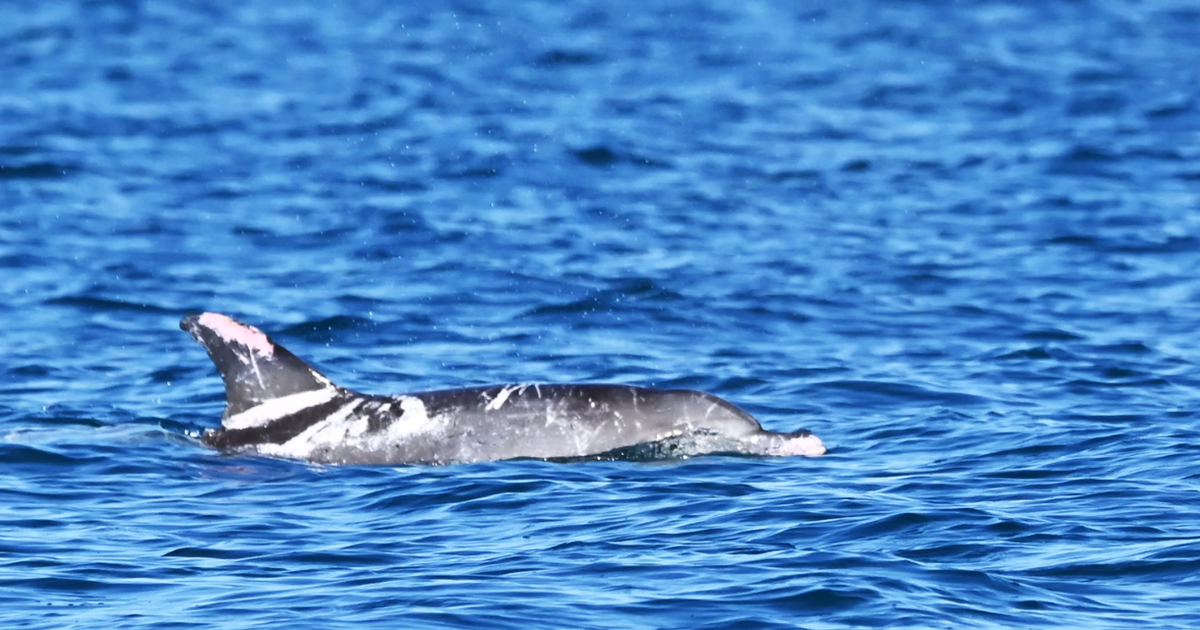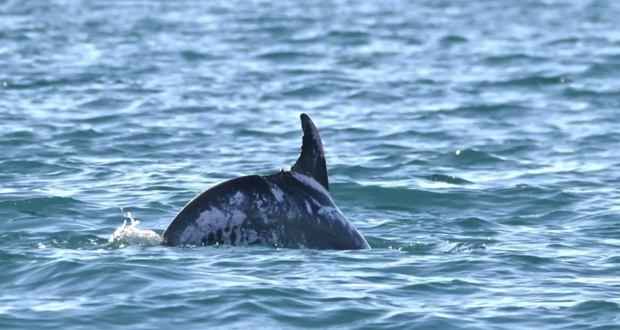CBS News
Meet Speckles, one of the world’s only known dolphins with “extremely rare” skin patches

There’s a bottlenose dolphin swimming through Australia’s waters that’s anything but typical. Researchers say the marine mammal is covered in a rare coloration that only a handful of other dolphins that have been photographed have and that earned it a unique name: Speckles.
While surveying Southern Queensland’s Hervey Bay in September 2022, researchers with Australia’s University of the Sunshine Coast said they spotted a pod of half a dozen dolphins. That’s when one dolphin leapt out of the water – and left the researchers stunned.
“Speckles leapt out of the water three times in an upright, vertical position, while the rest of the group traveled in a ‘porpoising’ movement,” researcher and lead author of the study documenting the dolphins, Georgina Hume, said in a news release from the university. “This allowed us to get a very clear look at its underside which had many white areas, along with white stripes across its dorsal and lateral sides.”
Georgina Hume/University of the Sunshine Coast
The “near-symmetrical white patches” hadn’t previously been seen in their years-long research of the species. And because the dolphin appeared to be healthy overall – aside from a healed shark bite on its side – researchers said that eliminated the possibility the discoloration could have been caused by disease or sunburn.
So what caused it? An “extremely rare skin condition” called piebaldism, the university said. It’s so rare that Speckles is one of only 24 reported cases in dolphins and one of only six photographed cases of dolphins having the condition in the world. This is the first documented case among the species in Australia, and the second documented in the southern hemisphere.
Behavioral ecologist Alexis Levengood said in the university’s news release that the condition is similar to albinism, a genetic mutation that results in the absence of melanin, and leucism, the partial loss of pigmentation that, unlike albinism, doesn’t affect the eyes.
Georgina Hume/University of the Sunshine Coast
“Piebaldism is a partial-loss of pigmentation so the individuals show this patchy coloration,” Levengood said in the release. She also told the Australian Broadcasting Corporation that “the best part of science happening in real life is where you get to see something for the first time and really experience it.”
“I’ve worked in this field for about 15 years across three different continents,” Levengood told ABC, “and I’ve never seen it myself firsthand, so once we brought back the photos it was a pretty exciting afternoon for us.”
The discovery was published in the scientific journal Aquatic Mammals.
Researchers don’t yet know the dolphin’s sex, but they hope to get more images, as well as conduct genetic sampling, to learn more about the condition.
While Speckles is one of only a few dolphins known to have the condition, there are more documented cases among other species.
CBS News
The Scott Peterson case: New evidence?

What started out as a college romance ended in murder and mystery.
1994 – Scott Peterson and Laci Rocha met in 1994 while both were attending college at California Polytechnic State University. They married two years later. In 2002, Laci became pregnant. The two lived in Modesto, California and planned to raise their unborn son Conner there.
Laci Peterson Missing
December 24, 2002 – Scott Peterson says that on Christmas Eve morning, he left his pregnant wife alone to go fishing about 90 miles away at the Berkeley Marina. He says that Laci planned to walk the couple’s dog, McKenzie, and mop the kitchen floor. When Scott returned home hours later, he says he found McKenzie there alone, still wearing a leash – but no sign of Laci. That evening, Laci’s stepfather called the police to report her missing.
Searching for Laci
Family, friends, and volunteers launched a huge search for Laci Peterson.
Scott Peterson was interviewed by police in the early hours of Christmas Day. Now-retired Modesto Police Detective Jon Buehler says Scott didn’t seem as interested as one would expect. “Oftentimes, a victim who’s left behind is firing tons of questions at us … And we didn’t get any of that from him,” Buehler told “48 Hours.”
Amber Frey
December 30, 2002 – Less than a week after Laci Peterson went missing, Modesto detectives raced over to investigate an intriguing lead: a Fresno massage therapist named Amber Frey revealed that she had been dating Scott Peterson for over a month. She told police that Peterson had lied to her and said he was single.
Secret Recordings
Former Detective Buehler notes, “Her recall was fantastic. It was almost like it was a script from a Hallmark TV show or something.” Amber Frey recalled every detail of their romantic dates, down to what they were wearing. Hoping for clues that might lead them to the missing woman, detectives ask Frey to record phone calls between her and Scott Peterson, and she agrees.
Affair Revealed
January 24, 2003 – In an explosive press conference one month after Laci Peterson goes missing, Amber Frey publicly reveals her affair with Scott Peterson. “I am very sorry for Laci’s family and the pain that this has caused them,” she said. “And I pray for her safe return, as well.”
Prior to Frey going public, Peterson had told her in a recorded call that he was in Paris when he was really in Modesto while the search for Laci was still on. Eventually Scott admitted to her, “I’ve lied to you that I’ve been traveling.” Those recorded calls would later become part of a damning case against Peterson.
Bodies Found
April 13 and 14, 2003 – Two bodies are found on the shores of the San Francisco Bay. They are later identified as Laci Peterson and her unborn child. The two bodies were found about a mile apart.
Scott Peterson Arrested
April 18, 2003 – Authorities caught up with Scott Peterson at a golf course in San Diego and arrested him. Authorities found a wad of cash, his brother’s ID card, and multiple cell phones inside the vehicle. Days later, Peterson pleaded not guilty to two counts of capital murder.
Trial and Error
June 1, 2004 – Scott Peterson’s trial begins in San Mateo County, California. Because of massive publicity the trial was moved from Modesto to Redwood City, in San Mateo County. The decision was made because the judge decided it would be difficult for Peterson to get a fair trial too close to home, where emotions were running high.
High Suspicions
August 10, 2004 – In what many consider a major turning point of the trial, Amber Frey took the stand for the first time to tell the jury about her relationship with Scott Peterson, a secretly married man, and about all the lies he told her. Frey painted a picture of a dishonest man who could tell falsehoods with ease, hurting his credibility.
Jurors heard the lies for themselves in those recorded phone calls Frey made.
Justice for Laci and Conner
November 12, 2004 – Scott Peterson was found guilty of first-degree murder for the death of his wife Laci and second-degree murder for the death of his unborn son Conner. Crowds outside cheer.
Peterson Jurors
March 16, 2005 – Four months after his conviction, Scott Peterson is sentenced to death. At a press conference, Juror No. 7, Richelle Nice, [pictured center] called Peterson a “jerk” and commented “San Quentin is your new home,” referring to the prison where he would serve his sentence. Nice was nicknamed “Strawberry Shortcake” during the trial because of her hair color.
Death Sentence Overturned
August 24, 2020 – After two appeals, Scott Peterson’s death sentence was overturned by the California Supreme Court after deciding that the original trial judge made a mistake when jurors were being picked for trial. The result of that mistake, Peterson’s supporters say, was that the jury was stacked with pro death penalty jurors. Peterson, shown here in 2018, will now receive a new trial for only the sentence phase.
The court upheld his murder convictions.
Juror No. 7
October 14, 2020 – The California Supreme Court orders a lower court to reexamine Peterson’s murder convictions and decide if he should get an entire new trial. Scott Peterson’s supporters say it all comes down to the actions of that juror once nicknamed “Strawberry Shortcake” – Richelle Nice, pictured here in 2005.
During jury selection, prospective jurors filled out a questionnaire asking if they had in the past been in a lawsuit and if they had been crime victims. Nice checked no. “It’s pretty clear… that she lied to us straight to our face about her own situation,” Peterson’s current attorney Pat Harris told “48 Hours.” In fact, Nice was involved in two domestic disputes in the past. But prosecutors say when Nice filled out that questionnaire she didn’t lie, she just didn’t think her past experiences were relevant to the questions and didn’t see herself as a victim. Now a lower court will consider if Peterson will get a complete retrial. Richelle Nice declined to speak with “48 Hours.”
New Evidence?
March 7, 2021 – CBS News’ Jonathan Vigliotti interviewed Scott Peterson’s sister-in-law Janey Peterson in her “war room” of evidence she claims proves his innocence. She claims witnesses saw Laci walking in the neighborhood near the Peterson home after the time Scott said he left for the fishing trip. If that’s true, Scott couldn’t have killed Laci.
Scott Peterson’s attorney explains, “there’s been a lot of criticism because we didn’t call some witnesses who saw Laci that day,” and that the thought process at the time was that “a number of the witnesses who saw her didn’t have great – memories or had contra – were contradicting each other.”
Retired detective Jon Buehler says there are no witnesses who saw Laci alive that morning. He says there were other young women in the neighborhood who were pregnant and looked similar to Laci, and that “it would be real easy for somebody to mistakenly see one of those three girls as being Laci.” Still, Janey Peterson insists that Scott is innocent.
A Burglary
Perhaps more important to a new defense case is what Janey Peterson believes actually happened to Laci. She points to a burglary she believes happened on the same day Laci disappeared, right across the street from the Peterson home. Scott Peterson’s supporters theorize that Laci confronted the burglars and that ended badly. But police quickly arrested the burglars – Steven Todd and Donald Pearce – pictured here in a 2003 Modesto Police Department press release.
Awaiting a Decision
April 27, 2021 – Scott Peterson appeared in court remotely for a status hearing on a new death penalty trial.
Dec. 8, 2021: Scott Peterson was resentenced to life in prison without the possibility of parole for the deaths of his wife and unborn child.
2024: The Los Angeles Innocence Project took up Peterson’s fight for a new trial. Since then, a California judge has granted his defense team access to previously undisclosed evidence as well as permission to do additional DNA testing.
Peterson and his supporters maintain the wrong man is in prison for Laci and Conner’s deaths. According to Detective Buehler, “Well, I guess it’s possible. But you know, there’s still people that believe the Earth is flat too.”
CBS News
Will the bill to avert a government shutdown pass without Trump’s support?

Watch CBS News
Be the first to know
Get browser notifications for breaking news, live events, and exclusive reporting.
CBS News
Why is there new hope for a ceasefire in Gaza?

Watch CBS News
Be the first to know
Get browser notifications for breaking news, live events, and exclusive reporting.



























